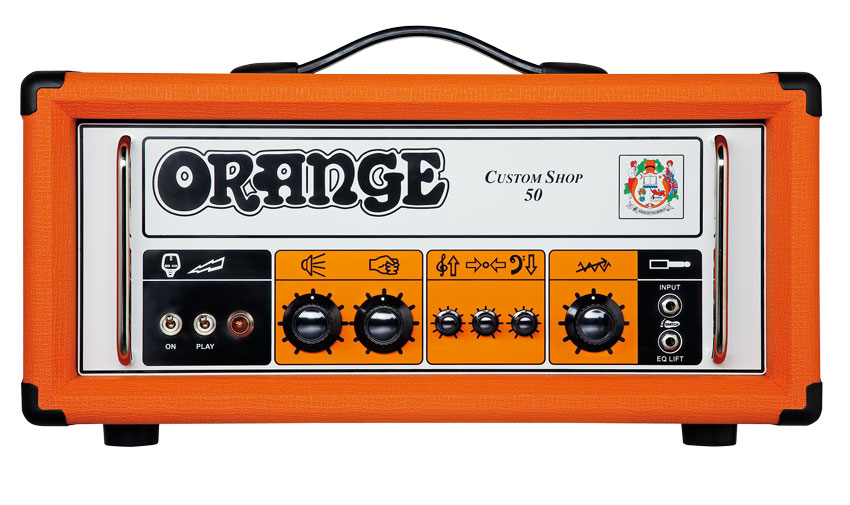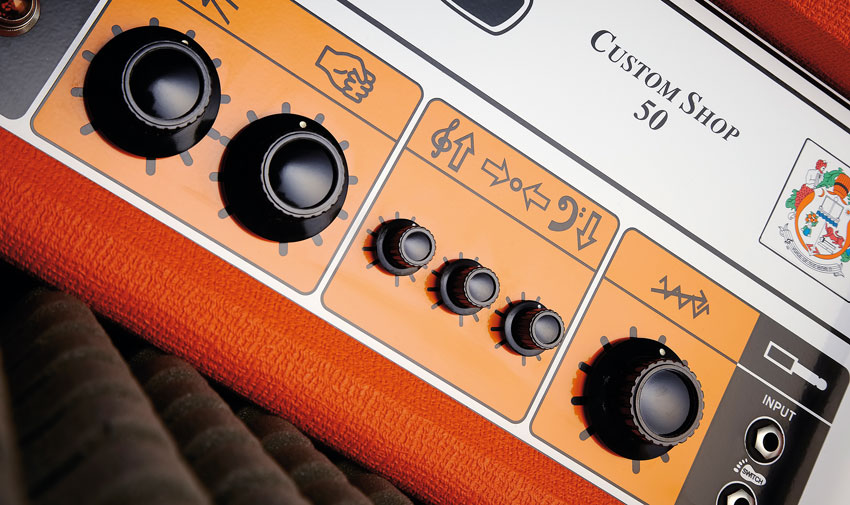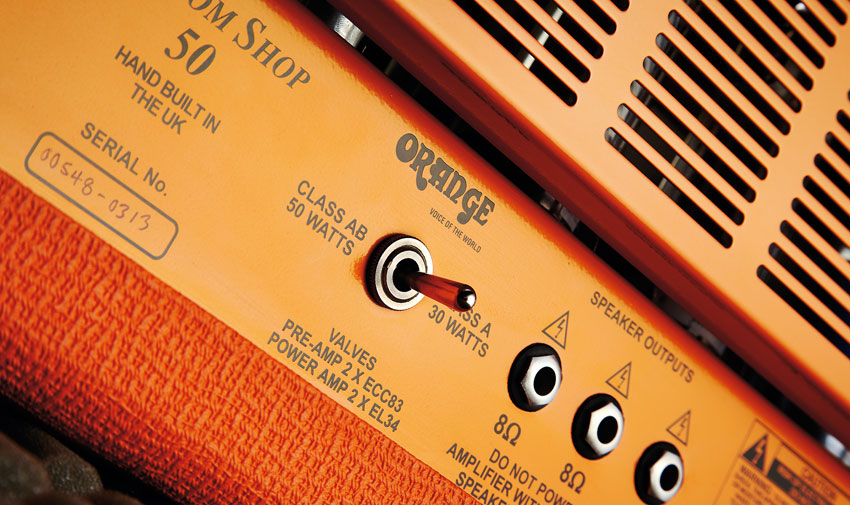MusicRadar Verdict
The most satisfying straight-up 50-watt classic rock head we've played in decades. Good value for what it is, too.
Pros
- +
No compromise design. Heart-melting rock tones. Good value.
Cons
- -
No effects loop.
MusicRadar's got your back

Orange Custom Shop 50 review

Controls

Rear
Even if there were such a thing as a 'normal' Orange valve amp, you couldn't really say they were made down to a price. Tonally, too, Guitarist has registered precious few complaints at the brand's regular UK-made amps these past decades, thanks to strong build and world-class tones. Nevertheless, the company is revisiting its highest-spec Custom Shop treatment for its latest model. So, no bells, no whistles: just one channel, four valves, 50 watts and a lifetime of hand-wiring experience.
Grunt. Nearly 20 kilos for a medium-sized head with not much in it hints at some hefting great transformers, a sturdy steel chassis, solidly constructed cabinet and all the other over-spec'd details you'd expect from Orange. Check.
"This level of care and workmanship is rare, but it's done so that your amp can outlast a lifetime of pro use"
Nothing quite prepares you for the view of the inside, however, which in addition to the cockle- warming, predominantly point-to-point wiring layout (there are two meticulous turret boards as well), also features some extra attention to detail over the regular production-line amps, such as full internal powder-coating.
This level of care and workmanship is rare, but more importantly, it's done so that your amp can outlast you and a lifetime of pro use. It's easy to service and easy to repair (by a suitably qualified tech, of course).
In terms of functions and features, you might think a straight-up single-channel amp is a bit simplistic in 2013, but the combination of Orange's gain, interactive tone section and HF Drive (presence) controls can return a very wide range of sounds.
Designer Adrian Emsley has explained to us before that the HF Drive works as a presence control in the power section up until around eight on the dial. After that, it adds negative feedback to "really make it scream". There's also a footswitchable 'EQ lift' function that gives you a gain and tone boost. Don't look for any control names, though; the CS 50 celebrates Orange's 'pics only' amps with little quirky graphic symbols to represent the knob functions.
With no reverb built in, the lack of an effects loop might seem like an oversight, even though many amp purists would argue they're always a tonal compromise. There are other Orange amps that offer all of the above should you want them but the CS 50's raison d'etre is simplicity, so the valve complement remains minimal: a pair of ECC83/12AX7s in the front end and a pair of EL34s for the power stage. A switch on the back panel lets you configure the power section for either 50 watts class AB, or 30 watts in class A.
Want all the hottest music and gear news, reviews, deals, features and more, direct to your inbox? Sign up here.
Sounds
"The overdriven tones that this beast of a head kicks out are some of the most satisfying we've heard from any amp"
The thick, juicy overdriven tones that this beast of a head kicks out are some of the most satisfying we've heard from any amp. It's a pleasure to experience, slightly less so to explain, because it's so full of apparent contradictions.
You get a strong, powerful core to the tone - that chest-thumping kind of thing that good Marshall Plexis seem to have, but JCM900s and DSLs lack. But there's also a distortion character that successfully tiptoes the fine line between soft and smooth, and edgy and cutting: no other amplifiers we recall can do it quite like this.
From early Fleetwood Mac through AC/DC to Oasis, Foo Fighters and QOTSA, there's plenty of vintage and contemporary stylistic range on board. All the best bits of the Orange sound seem to be pulled into sharp focus and rendered even more vivid, perhaps as a result of the uncompromising nature of this amp's construction. It's worth noting that this level of tonal depth and detail does seem to be the preserve of the best hand-wired single-channel amps.
Even in 50-watt Class AB mode through a high-power handling 4x12, it'd never be a choice for pristine, scooped cleans. Nope, there is always some whiskey in your water, if you will, which means you'll find it oh-so satisfying if you're the type of player who rides your guitar's volume knob to regulate drive. Don't be afraid to push that master if you want more headroom, either - it just keeps getting louder - and while you're at it, this is where you hear the most effective sharpening, defining effect of the HF Drive (presence) control, too.
It's normally at this point that we'd say that if you don't like your amps too visceral and revealing (as we would with a hand-wired Plexi or H&K's Puretone), look elsewhere. Not here: the interaction of the CS 50's gain, EQ and HF controls means that you can dial in a really impressive range of responses from full-on, brick- in-the-face punch, to a softer-edged, more compressed overdrive delivery.
The EQ lift function is a useful addition, not so much as a solo boost, because there's no great hike in volume, but as a switchable extra level of gain and 'fullness' to your tone. For example, if you like the way your rhythm sounds have good note definition with your regular sound, kicking in the EQ lift will give you enough extra sustain and drive to make those solos really fluid, albeit without changing the core sound too dramatically.
The sonic differences between the class A/30-watt, and class AB/50-watt modes are more evident in the room and under your fingers than on tape and through your ears. There's more chime and complexity to the high-end and upper mids in the class A setting, perhaps a little more touch-sensitivity under your fingers at those crucial 'neither clean nor filthy' gain settings.
"Don't expect the 30-watt setting to be much quieter - at certain volumes we'd even say it sounds louder!"
Don't expect the 30-watt setting to be much quieter - at certain volumes we'd even say it sounds louder! Which power setting do we prefer? Impossible to say: with a Telecaster barking out Georgia Satellites-type rock, we like class A; with a Les Paul for full-blooded blues rock, it's 50-watt class AB all the way.
There are barely a handful of point-to-point-wired, no-compromise 50-watt amp heads available from any manufacturer. So even if it's only in the interests of pure education, do yourself a favour and A/B the Custom Shop 50 against your regular, run of the mill 50-watt PCB-based amp from any of the big names. What Orange has achieved here is palpably more refined.
In the real gigging world, the minimal feature set might make it unusable for many players, but if your needs are focused on simple, straight-up plug-in-and-go rock tone, this will keep you inspired, grinning and heard night after night after night.
You'll have no trouble imagining any number of amps that are trying to be something else. This is the absolute opposite: the CS 50 stands proudly and resolutely unique, and for that we like it a lot. In fact, we might just love it.